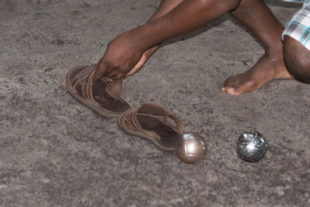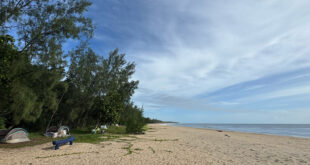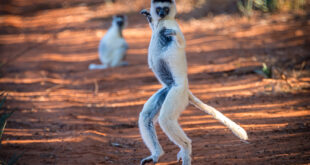No matter where you travel in Madagascar: At some point, you will encounter people playing with silver balls on a piece of flat ground. The balls are usually worn, the carved lines on them barely recognizable, and the balls themselves are barely round from being used so much. The game is called pétanque and, except for its country of origin, is probably played nowhere else in the world with as much pleasure as in Madagascar.
The game of petanque originated in the south of France, where it was invented at the beginning of the 20th century. At the same time, France ruled as a colonial power over the tropical island of Madagascar. And the French brought not only weapons and industry to Madagascar but also the game of pétanque. Although the colonial period was not a particularly good time in the memory of most Madagascans, pétanque enjoys amazing popularity throughout the country.

The word pétanque comes from the dialect of French Provence for “closed feet,” ped tanco. It describes the foot position in which you throw the balls, as opposed to Jeu provençale, in which you take three steps before throwing the ball. It is probably the simplicity of pétanque that makes the game so popular in Madagascar. There is no need for an extra playing field, no barriers around the perimeter, or a special surface. It can be played on almost any ground that provides a reasonably level playing field of at least 12 x 3 m². Before the game, a draw is made to determine which team will start throwing the target ball first and thus get to choose the playing field. A player from the same team also determines the throwing circle, which must be between six and ten meters from the target ball. Both teams play from this throwing circle. Each player then has two or three metal balls between 650 and 800 grams.
Skilled players “read” the ground before the game, crouching down and looking closely at every bump. Obstacles such as branches or hills may not be removed during the game. Before a throw, each player is allowed to blur with his foot only exactly one hole created by the impact of a ball on the ground. Therefore, the player must take into account the ground conditions in advance in his tactics and playing style.
The balls are thrown alternately. You try to throw the balls as close as possible to the smaller, wooden target ball, the so-called piggy. In pétanque, there are two ways to get the ball close to the piggy: Laying and shooting. In the case of laying, a distinction is made between the half-throw, in which the ball touches the ground halfway and then rolls on, and the real throw, in which the ball touches down just before the piggy and rolls only a short distance across the ground. In addition, the half throw, in which the ball touches down directly behind the dropping circle and rolls the entire distance to the target ball, belongs to the laying. Shooting, on the other hand, is used to specifically clear opposing balls from the field or to change constellations. If you shoot another ball directly, you perform a so-called tir au fer, or iron shot.
Once all the balls have been thrown, you evaluate the shot: Whose ball is closest to the target ball, whose team gets a point. Additional points are awarded if several balls of the same team are closer to the target ball than the balls of the opposing team. The team that scores 13 points is the winner – so at least three shots must always be played.

Pétanque can be played by people of all ages, with and without physical infirmities. This also makes this sport popular in Madagascar. Those who are particularly skilled with the balls can specifically shoot opposing balls away from the target ball during the game and bring balls of their own team closer to the target ball. Sometimes the target ball itself flies through the area and completely new constellations are created. This makes pétanque exciting and interesting. In Madagascar, measuring is especially crucial when two balls are similarly close to the target ball. Actually, you take the so-called tirette, a folding ruler, for measuring. In the countryside, however, people also measure with string, fingers, or simply their bare feet.
Those who play professionally, on the other hand, can compete with others. This is possible as a single (tête-à-tête), in doubles (doublette) or in threes (triplette). Madagascar has been a member of the Fédération Internationale de Pétanque et Jeu Provençal (F.I.P.J.P.), the international and largest federation of the game. The federation hosts the World Pétanque Championships every year. The next World Championship will be held in Denmark in 2022. Other important competitions include the World Games and the Indian Ocean Island Games, both of which are held every four years.
Until 2019, the Fédération Malagasy de Pétanque (FMP) acted as the lead Malagasy sports federation. However, due to various quarrels within the FMP, the federation’s international playing license was withdrawn in 2019. As a result, the new Malagasy sports federation Fédération Sport Boules Malagasy (FSBM) was founded in Antananarivo the same year and was promptly recognized as a new member of the international pétanque federation. It is therefore still possible for Malagasy pétanque players to participate in international competitions. Madagascar has been the reigning world champion in pétanque (men’s Triplette) since 2016. The Madagascans won the second world championship title after 1999 in their own country, in the capital Antananarivo. Already three times (1982, 2007, and 2010) Madagascar became vice world champion in pétanque.
Cover image: © JMDZ, licensed from AdobeStocks.
Pétanque at the beach: © moramora, licensed from AdobeStocks
 MADAMAGAZINE Your Magazine about Madagascar
MADAMAGAZINE Your Magazine about Madagascar




